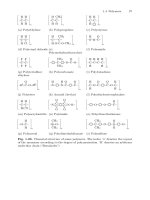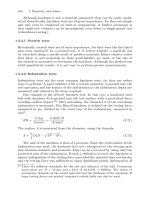Mechanical Behaviour of Engineering Materials - Metals, Ceramics, Polymers and Composites 2010 Part 12 potx

Mechanical Behaviour of Engineering Materials - Metals, Ceramics, Polymers and Composites 2010 Part 12 potx
... denotes the total concentration of B, c A the B concentration in the A-rich phase, and c B the B concentration in the B-rich phase, the masses m A and m B of the A- and B-rich phase are given by the ... nor particles with its environment. The statement of the first law is nothing but the law of the conservation of energy. To understand the second law, we need to think about the...
Ngày tải lên: 11/08/2014, 15:20

Mechanical Behaviour of Engineering Materials - Metals, Ceramics, Polymers and Composites 2010 Part 2 doc
... material: C 11 = S 11 + S 12 (S 11 − S 12 )(S 11 + 2S 12 ) , (2.38a) C 12 = − S 12 (S 11 − S 12 )(S 11 + 2S 12 ) , (2.38b) C 44 = 1 S 44 (2.38c) and S 11 = C 11 + C 12 (C 11 − C 12 )(C 11 + 2C 12 ) , (2.39a) 14 As ... 2ν) (1 − ν)ε 11 + ν(ε 22 + ε 33 ) (2.25a) and σ 12 is given by σ 12 = Gγ 12 . (2.25b) Apart from E, G, and ν, the so-called Lamé’s elastic co...
Ngày tải lên: 11/08/2014, 15:20

Mechanical Behaviour of Engineering Materials - Metals, Ceramics, Polymers and Composites 2010 Part 4 docx
... crack-growth resistance or crack-extension resis- tance K IR . 12 The crack-growth resistance initially increases in materials form- ing a process zone, a behaviour frequently denoted R curve behaviour. ... not to depart too far out of the region of smallest cross section. On the one hand, this is due to the smaller stress level in the thicker parts of the specimen. On the other...
Ngày tải lên: 11/08/2014, 15:20

Mechanical Behaviour of Engineering Materials - Metals, Ceramics, Polymers and Composites 2010 Part 5 doc
... crystal parts is called the slip plane, and the combination of slip direction and slip plane is called a slip system. Figure 6 .12 illustrates slipping of a crystal with the slip direction and the slip ... figure 6.3. 176 6 Mechanical behaviour of metals (a) Close-packed plane or direction. Slip is relatively easy, as the upper array of spheres has to be lifted only slightly...
Ngày tải lên: 11/08/2014, 15:20

Mechanical Behaviour of Engineering Materials - Metals, Ceramics, Polymers and Composites 2010 Part 6 ppt
... elastically, and the stiffness increases. In the context of fibre- and plate-shaped particles this will be discussed further in chapter 9. The amount of load transfer depends strongly on the shape of the particles and ... strength and the decrease in ductility for different states of deformation of pure aluminium and an aluminium alloy. One advantage of work hardening is th...
Ngày tải lên: 11/08/2014, 15:20

Mechanical Behaviour of Engineering Materials - Metals, Ceramics, Polymers and Composites 2010 Part 7 pptx
... Time-dep endent deformation of polymers 265 (a) Kelvin model (b) Four-parameter model Fig. 8.7. Mechanical models of viscoelastic and viscoplastic materials, built as systems containing spring and ... the first, and thus critical, 258 8 Mechanical behaviour of polymers −180 120 −60 0 60 120 180 rotational angle ϕ/° energy carb on hydrogen Fig. 8.1. Sketch of the poten...
Ngày tải lên: 11/08/2014, 15:20

Mechanical Behaviour of Engineering Materials - Metals, Ceramics, Polymers and Composites 2010 Part 8 pot
... Araneus diadematus and 8.4 Plastic behaviour 275 Table 8.1. Cross-linking density and Young’s modulus of different types of polymers (cf. section 1.4.2) type of material cross-linking density E/GPa thermoplastics ... chain molecules is larger and enables 9 Mechanical behaviour of fibre reinforced composites In composites, different materials are combined to exploit fav...
Ngày tải lên: 11/08/2014, 15:20

Mechanical Behaviour of Engineering Materials - Metals, Ceramics, Polymers and Composites 2010 Part 9 pot
... application of ceramic matrix composites are cutting tools made of SiC-whisker reinforced aluminium oxide for cutting of hard-to-machine materials, especially nickel- base superalloys and hardened ... enamel. 314 9 Mechanical behaviour of fibre reinforced composites ¾ ¾ ¾ ¾ Fig. 9.11. Deformation of a fibre composite under compressive stress. The fibres can b end in an in-ph...
Ngày tải lên: 11/08/2014, 15:20

Mechanical Behaviour of Engineering Materials - Metals, Ceramics, Polymers and Composites 2010 Part 10 pptx
... glass 40 % C Fig. 10.25. Comparison of the S-N curves of unreinforced as well as glass- and carb on-reinforced polysul fone (simplified plot after [29]) S-N curves of fibre composites According to section ... consequence of what we discussed above concerning the mean-stress dependence of ∆K th , ∆K Ic , and da/dN . In equa- tion (10.8), this shift of the curve is accounted for...
Ngày tải lên: 11/08/2014, 15:20